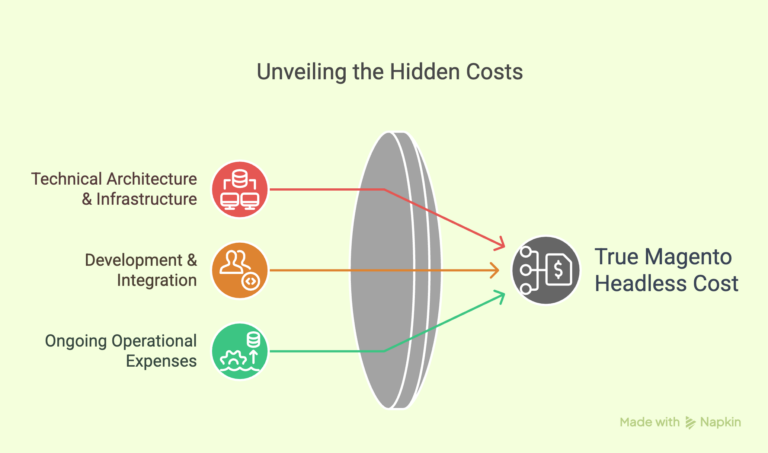Greetings! I'm Aneesh Sreedharan, CEO of 2Hats Logic Solutions. At 2Hats Logic Solutions, we are dedicated to providing technical expertise and resolving your concerns in the world of technology. Our blog page serves as a resource where we share insights and experiences, offering valuable perspectives on your queries.

Quick Summary
These figures represent general estimates and will vary significantly based on business requirements, project complexity, existing infrastructure, and implementation approach:
Key Performance Gains: Substantial improvements in site speed, conversion rates, and development agility
Ongoing Costs: Typically 15-30% of initial investment annually, depending on support needs
Infrastructure Costs: Generally higher than traditional implementations, but highly variable
Have you been considering a headless Magento implementation but find yourself hesitating at the potential costs?
You’re not alone. As businesses increasingly demand flexible, high-performance commerce solutions, headless architectures have moved from luxury to necessity.
Understanding the true Magento headless cost remains challenging for many decision-makers.
Let’s break down exactly what you’re paying for, where you can save, and what investments deliver the greatest returns.
The True Magento Headless Cost: Beyond the Surface Numbers
When evaluating a headless Magento implementation, many organizations focus solely on the initial development costs. This perspective, while understandable, lacks the strategic depth needed for proper budgeting.
A comprehensive Magento headless cost analysis must account for several interdependent components:

1. Technical Architecture & Infrastructure Costs
The foundation of your headless implementation directly impacts both immediate expenses and long-term operational costs.
| Component | Traditional Magento | Headless Magento |
|---|---|---|
| Hosting Infrastructure | $500-$3,000/month | $800-$5,000/month |
| CDN Services | Optional | Essential ($200-$1,000/month) |
| API Management | Minimal | Significant ($300-$1,500/month) |
| Performance Optimization | Frontend-focused | Distributed (20-40% higher) |
The specific architecture you choose dramatically affects your Magento headless cost structure.
For instance, a decoupled architecture using Vue Storefront might cost 15-25% more initially than a React-based PWA Studio implementation but could offer lower maintenance costs and better performance depending on your specific requirements.
2. Development & Integration Expenses
This represents the most substantial initial investment in your headless transformation.
The typical development budget breakdown for a mid-sized B2B company implementing headless Magento includes:
- Backend development and API customization: 35-40% of total development cost
- Frontend framework implementation: 30-35%
- Third-party integrations: 15-20%
- Testing and quality assurance: 10-15%
Based on our experience at 2HatsLogic, a medium-complexity headless Magento implementation for an established business typically ranges from $120,000 to $350,000 in development costs. However, this figure can vary significantly depending on several factors.
Pro tip: Consider a phased implementation approach to distribute the Magento headless cost over multiple budget cycles. Start with your highest-traffic customer journeys, then extend the architecture as you validate performance improvements.
3. Ongoing Operational Expenses
The long-term Magento headless cost includes maintenance, updates, and continuous improvement.
Maintenance considerations include:
- Separate frontend and backend update cycles
- API versioning and compatibility management
- Performance monitoring across multiple systems
- Security oversight for a distributed architecture
For a typical mid-market headless implementation, expect ongoing operational costs to run approximately 15-25% of your initial implementation costs annually.
This represents an increase of roughly 30-40% compared to traditional Magento implementations, but is offset by improved performance and business flexibility.
Get a custom headless Magento architecture assessment tailored to your specific business.
Hidden Costs and Considerations in Headless Magento
Beyond the obvious line items, several less apparent Magento headless cost factors can significantly impact your total investment:
1. Team Capability Development
Your existing team likely needs additional training or supplementation to effectively manage a headless architecture.
This transition typically adds 8-15% to your first-year implementation costs through:
- Training programs for existing staff
- New specialist hires (particularly frontend developers with headless experience)
- External consulting during the transition period
2. Content Management Reconfiguration
Traditional Magento content workflows don’t translate directly to headless architectures, creating potential Magento headless cost increases in content production.
You’ll need to consider:
- Potential investment in a dedicated headless CMS
- Restructuring of content workflows and governance
- Content migration and reformatting
- Training for marketing and merchandising teams
3. Testing and Quality Assurance Expansion
The distributed nature of headless architecture expands testing requirements, often adding 20-35% to QA budgets compared to monolithic implementations.
Additional testing considerations include:
- API contract testing
- Frontend performance across multiple devices
- Integration testing between decoupled systems
- Automated regression testing
Optimizing Your Headless Magento Investment
Understanding the Magento headless cost is only the first step. Here’s how to maximize your return on investment:
1. Strategic Phasing and Prioritization
Rather than implementing everything at once, consider a strategic approach:
- Begin with high-value customer journeys (typically product discovery and checkout)
- Gradually extend to secondary features
- Implement A/B testing to validate performance improvements
This approach not only distributes the Magento headless cost but also allows you to demonstrate ROI earlier in the implementation cycle.
2. Reusable Component Development
One significant advantage of headless architecture is component reusability. By investing in a well-designed component library upfront, you can reduce long-term development costs by 20-30%.
3. Leverage Existing Infrastructure Where Possible
Not everything needs replacement in a headless implementation. At 2HatsLogic, we frequently help clients identify which elements of their existing infrastructure can be repurposed, often reducing total Magento headless cost by 15-25%.
Pro-tip: Create a comprehensive technology inventory before beginning your headless implementation. Identify which systems can be maintained, which need replacement, and which can be gradually phased out to optimize your investment timeline.
ROI Metrics: Measuring Headless Magento Success
The true value of a headless implementation comes from business outcomes, not technical achievements.
Here’s how our clients typically measure the return on their Magento headless cost investment:
- Performance Improvements:
- Page load time reductions of 40-60%
- Conversion rate improvements of 15-30%
- Mobile performance scores increasing by 20-40 points
- Business Agility:
- Time-to-market for new features reduced by 30-50%
- A/B testing implementation time decreased by 60-80%
- Ability to deploy frontend changes without backend modifications
- Customer Experience Enhancement:
- Reduced bounce rates (typically 15-25% improvement)
- Increased average session duration (10-20% improvement)
- Higher customer satisfaction scores (NPS improvements of 10-15 points)
Making the Right Decision for Your Business
While the Magento headless cost is substantial, the question shouldn’t be “Can we afford to implement headless Magento?” but rather, “Can we afford not to?”
As commerce continues to evolve toward omnichannel experiences, API-first architectures, and personalized customer journeys, headless implementations provide the flexibility and performance needed to remain competitive. However, timing and approach matter significantly.
Consider these factors when deciding on your headless implementation:
- Current Technical Debt: Businesses with aging Magento implementations often see greater ROI from headless migrations.
- Growth Trajectory: Companies experiencing rapid growth or entering new markets benefit disproportionately from the scalability of headless architecture.
- Competitive Landscape: Industries where user experience is a primary differentiator typically justify higher investment in headless implementations.
Our experienced team can help you navigate the complexities of headless architecture while maximizing your return on investment.
Contact us today for a personalized consultation and discover how we can help you build a more flexible, performant commerce experience without unnecessary cost overruns.
FAQ
What are the main cost factors in a headless Magento project?
The primary cost factors include frontend framework development, API customization, infrastructure changes, team training, third-party integrations, and quality assurance testing. Infrastructure and specialized development skills represent the most significant expenses.
Does headless Magento provide measurable ROI?
Yes. Businesses typically see 40-60% faster page loads, 15-30% higher conversion rates, and 30-50% faster time-to-market for new features. These performance improvements directly translate to revenue gains that offset implementation costs.
Can I implement headless Magento in phases to manage costs?
Absolutely. A phased implementation approach allows you to distribute costs across multiple budget cycles while prioritizing high-impact customer journeys first. This strategy enables earlier ROI validation and more controlled resource allocation.

Related Articles






